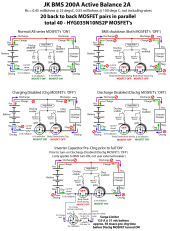Excellent demonstration!
The same caveats apply to depending on a BMS to interrupt overcurrent.
There are limits to how much current can be pulled through a BMS in a "hard" short circuit. Exceed those limits and the result is shorted MOSFETs. The most common failure mode for MOSFETs is to fail in a shorted source-to-drain condition. If a current flows exceeding the saturation current of the MOSFET junctions, it's all over. They're smoked. It's simply a limitation of the technology - not a manufacturing fault.
Overcurrent detection takes a significant amount of time to react and can't be relied upon to protect the BMS from an excessive short circuit current that will destroy the MOSFETs in microseconds - and then leave them in a shorted condition - sustaining the short circuit current. In other words, a potentially catastrophic failure (a nice name for "fire"). Usually, the failed and now shorted MOSFETs have the good graces to go up in smoke, finally interrupting the current, but only if the short circuit current is sustained long enough to thermally cook them into lumps of carbon.
I always place a fuse directly at the positive battery terminal to at least interrupt a sustained short circuit, albeit with the anticipated destruction of the BMS. The only protection for loss of BMS utility is ... have a spare BMS or a full set of replacement MOSFETs, which isn't a good option in a battery that must be cut open to access the BMS. The alternative is to use a BMS with electromechanical contactors instead of MOSFETs - and even contactors have limits on how much current can be interrupted before the contacts become welded closed.
Bottom line: never depend on a BMS to survive or interrupt a really large short circuit current. Add a fuse or circuit breaker sized for 2 times your maximum expected load/charge current and rated to interrupt the worst case short circuit current: pack voltage divided by the sum of all the series cell impedances. For a pack having typical cells with a series impedance of 0.25mΩ, the instantaneous short circuit current could be as high as 3.65V / 0.25mΩ = 14,600 amps! Neither a fuse nor a breaker will react quickly enough to save the BMS MOSFETs, so expect the BMS to get toasted. But a fuse or breaker will reduce the risk of sustained overcurrent causing everything else to go up in smoke.




